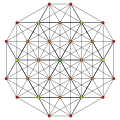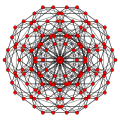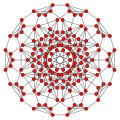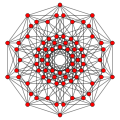| # | Base point | Name
Coxeter diagram | Element counts | Vertex
figure | Facet counts by location: [4,3,3,3] |
|---|
| 4 | 3 | 2 | 1 | 0 |       
[4,3,3]
(10) |       
[4,3,2]
(40) |       
[4,2,3]
(80) |       
[2,3,3]
(80) |       
[3,3,3]
(32) | Alt |
|---|
| 20 | (0,0,0,0,1)√2 | 5-orthoplex
triacontaditeron (tac)
         | 32 | 80 | 80 | 40 | 10 | 
{3,3,4} | - | - | - | - | 
{3,3,3} | |
|---|
| 21 | (0,0,0,1,1)√2 | Rectified 5-orthoplex
rectified triacontaditeron (rat)
         | 42 | 240 | 400 | 240 | 40 | 
{ }×{3,4} | 
{3,3,4} | - | - | - | 
r{3,3,3} | |
|---|
| 22 | (0,0,0,1,2)√2 | Truncated 5-orthoplex
truncated triacontaditeron (tot)
         | 42 | 240 | 400 | 280 | 80 | 
(Octah.pyr) | 
{3,3,4} | - | - | - | 
t{3,3,3} | |
|---|
| 23 | (0,0,1,1,1)√2 | Birectified 5-cube
penteractitriacontaditeron (nit)
(Birectified 5-orthoplex)
         | 42 | 280 | 640 | 480 | 80 | 
{4}×{3} | 
r{3,3,4} | - | - | - | 
r{3,3,3} | |
|---|
| 24 | (0,0,1,1,2)√2 | Cantellated 5-orthoplex
small rhombated triacontaditeron (sart)
         | 82 | 640 | 1520 | 1200 | 240 | 
Prism-wedge | 
r{3,3,4} | 
{ }×{3,4} | - | - | 
rr{3,3,3} | |
|---|
| 25 | (0,0,1,2,2)√2 | Bitruncated 5-orthoplex
bitruncated triacontaditeron (bittit)
         | 42 | 280 | 720 | 720 | 240 |  | 
t{3,3,4} | - | - | - | 
2t{3,3,3} | |
|---|
| 26 | (0,0,1,2,3)√2 | Cantitruncated 5-orthoplex
great rhombated triacontaditeron (gart)
         | 82 | 640 | 1520 | 1440 | 480 |  | 
t{3,3,4} | 
{ }×{3,4} | - | - | 
t0,1,3{3,3,3} | |
|---|
| 27 | (0,1,1,1,1)√2 | Rectified 5-cube
rectified penteract (rin)
         | 42 | 200 | 400 | 320 | 80 | 
{3,3}×{ } | 
r{4,3,3} | - | - | - | 
{3,3,3} | |
|---|
| 28 | (0,1,1,1,2)√2 | Runcinated 5-orthoplex
small prismated triacontaditeron (spat)
         | 162 | 1200 | 2160 | 1440 | 320 |  | 
r{4,3,3} | 
{ }×r{3,4} | 
{3}×{4} | | 
t0,3{3,3,3} | |
|---|
| 29 | (0,1,1,2,2)√2 | Bicantellated 5-cube
small birhombated penteractitriacontaditeron (sibrant)
(Bicantellated 5-orthoplex)
         | 122 | 840 | 2160 | 1920 | 480 |  | 
rr{3,3,4} | - | 
{4}×{3} | - | 
rr{3,3,3} | |
|---|
| 30 | (0,1,1,2,3)√2 | Runcitruncated 5-orthoplex
prismatotruncated triacontaditeron (pattit)
         | 162 | 1440 | 3680 | 3360 | 960 |  | 
rr{3,3,4} | 
{ }×r{3,4} | 
{6}×{4} | - | 
t0,1,3{3,3,3} | |
|---|
| 31 | (0,1,2,2,2)√2 | Bitruncated 5-cube
bitruncated penteract (bittin)
         | 42 | 280 | 720 | 800 | 320 |  | 
2t{4,3,3} | - | - | - | 
t{3,3,3} | |
|---|
| 32 | (0,1,2,2,3)√2 | Runcicantellated 5-orthoplex
prismatorhombated triacontaditeron (pirt)
         | 162 | 1200 | 2960 | 2880 | 960 |  | 
2t{4,3,3} | 
{ }×t{3,4} | 
{3}×{4} | - | 
t0,1,3{3,3,3} | |
|---|
| 33 | (0,1,2,3,3)√2 | Bicantitruncated 5-cube
great birhombated triacontaditeron (gibrant)
(Bicantitruncated 5-orthoplex)
         | 122 | 840 | 2160 | 2400 | 960 |  | 
tr{3,3,4} | - | 
{4}×{3} | - | 
rr{3,3,3} | |
|---|
| 34 | (0,1,2,3,4)√2 | Runcicantitruncated 5-orthoplex
great prismated triacontaditeron (gippit)
         | 162 | 1440 | 4160 | 4800 | 1920 |  | 
tr{3,3,4} | 
{ }×t{3,4} | 
{6}×{4} | - | 
t0,1,2,3{3,3,3} | |
|---|
| 35 | (1,1,1,1,1) | 5-cube
penteract (pent)
         | 10 | 40 | 80 | 80 | 32 | 
{3,3,3} | 
{4,3,3} | - | - | - | - | |
|---|
| 36 | (1,1,1,1,1)
+ (0,0,0,0,1)√2 | Stericated 5-cube
small cellated penteractitriacontaditeron (scant)
(Stericated 5-orthoplex)
         | 242 | 800 | 1040 | 640 | 160 | 
Tetr.antiprm | 
{4,3,3} | 
{4,3}×{ } | 
{4}×{3} | 
{ }×{3,3} | 
{3,3,3} | |
|---|
| 37 | (1,1,1,1,1)
+ (0,0,0,1,1)√2 | Runcinated 5-cube
small prismated penteract (span)
         | 202 | 1240 | 2160 | 1440 | 320 |  | 
t0,3{4,3,3} | - | 
{4}×{3} | 
{ }×r{3,3} | 
r{3,3,3} | |
|---|
| 38 | (1,1,1,1,1)
+ (0,0,0,1,2)√2 | Steritruncated 5-orthoplex
celliprismated triacontaditeron (cappin)
         | 242 | 1520 | 2880 | 2240 | 640 |  | 
t0,3{4,3,3} | 
{4,3}×{ } | 
{6}×{4} | 
{ }×t{3,3} | 
t{3,3,3} | |
|---|
| 39 | (1,1,1,1,1)
+ (0,0,1,1,1)√2 | Cantellated 5-cube
small rhombated penteract (sirn)
         | 122 | 680 | 1520 | 1280 | 320 | 
Prism-wedge | 
rr{4,3,3} | - | - | 
{ }×{3,3} | 
r{3,3,3} | |
|---|
| 40 | (1,1,1,1,1)
+ (0,0,1,1,2)√2 | Stericantellated 5-cube
cellirhombated penteractitriacontaditeron (carnit)
(Stericantellated 5-orthoplex)
         | 242 | 2080 | 4720 | 3840 | 960 |  | 
rr{4,3,3} | 
rr{4,3}×{ } | 
{4}×{3} | 
{ }×rr{3,3} | 
rr{3,3,3} | |
|---|
| 41 | (1,1,1,1,1)
+ (0,0,1,2,2)√2 | Runcicantellated 5-cube
prismatorhombated penteract (prin)
         | 202 | 1240 | 2960 | 2880 | 960 |  | 
t0,2,3{4,3,3} | - | 
{4}×{3} | 
{ }×t{3,3} | 
2t{3,3,3} | |
|---|
| 42 | (1,1,1,1,1)
+ (0,0,1,2,3)√2 | Stericantitruncated 5-orthoplex
celligreatorhombated triacontaditeron (cogart)
         | 242 | 2320 | 5920 | 5760 | 1920 |  | 
t0,2,3{4,3,3} | 
rr{4,3}×{ } | 
{6}×{4} | 
{ }×tr{3,3} | 
tr{3,3,3} | |
|---|
| 43 | (1,1,1,1,1)
+ (0,1,1,1,1)√2 | Truncated 5-cube
truncated penteract (tan)
         | 42 | 200 | 400 | 400 | 160 | 
Tetrah.pyr | 
t{4,3,3} | - | - | - | 
{3,3,3} | |
|---|
| 44 | (1,1,1,1,1)
+ (0,1,1,1,2)√2 | Steritruncated 5-cube
celliprismated triacontaditeron (capt)
         | 242 | 1600 | 2960 | 2240 | 640 |  | 
t{4,3,3} | 
t{4,3}×{ } | 
{8}×{3} | 
{ }×{3,3} | 
t0,3{3,3,3} | |
|---|
| 45 | (1,1,1,1,1)
+ (0,1,1,2,2)√2 | Runcitruncated 5-cube
prismatotruncated penteract (pattin)
         | 202 | 1560 | 3760 | 3360 | 960 |  | 
t0,1,3{4,3,3} | - | 
{8}×{3} | 
{ }×r{3,3} | 
rr{3,3,3} | |
|---|
| 46 | (1,1,1,1,1)
+ (0,1,1,2,3)√2 | Steriruncitruncated 5-cube
celliprismatotruncated penteractitriacontaditeron (captint)
(Steriruncitruncated 5-orthoplex)
         | 242 | 2160 | 5760 | 5760 | 1920 |  | 
t0,1,3{4,3,3} | 
t{4,3}×{ } | 
{8}×{6} | 
{ }×t{3,3} | 
t0,1,3{3,3,3} | |
|---|
| 47 | (1,1,1,1,1)
+ (0,1,2,2,2)√2 | Cantitruncated 5-cube
great rhombated penteract (girn)
         | 122 | 680 | 1520 | 1600 | 640 |  | 
tr{4,3,3} | - | - | 
{ }×{3,3} | 
t{3,3,3} | |
|---|
| 48 | (1,1,1,1,1)
+ (0,1,2,2,3)√2 | Stericantitruncated 5-cube
celligreatorhombated penteract (cogrin)
         | 242 | 2400 | 6000 | 5760 | 1920 |  | 
tr{4,3,3} | 
tr{4,3}×{ } | 
{8}×{3} | 
{ }×rr{3,3} | 
t0,1,3{3,3,3} | |
|---|
| 49 | (1,1,1,1,1)
+ (0,1,2,3,3)√2 | Runcicantitruncated 5-cube
great prismated penteract (gippin)
         | 202 | 1560 | 4240 | 4800 | 1920 |  | 
t0,1,2,3{4,3,3} | - | 
{8}×{3} | 
{ }×t{3,3} | 
tr{3,3,3} | |
|---|
| 50 | (1,1,1,1,1)
+ (0,1,2,3,4)√2 | Omnitruncated 5-cube
great cellated penteractitriacontaditeron (gacnet)
(omnitruncated 5-orthoplex)
         | 242 | 2640 | 8160 | 9600 | 3840 | 
Irr. {3,3,3} | 
tr{4,3}×{ } | 
tr{4,3}×{ } | 
{8}×{6} | 
{ }×tr{3,3} | 
t0,1,2,3{3,3,3} | |
|---|
| 51 | | 5-demicube
hemipenteract (hin)
         = =        | 26 | 120 | 160 | 80 | 16 | 
r{3,3,3} | 
h{4,3,3} | - | - | - | - | (16)

{3,3,3} |
|---|
| 52 | | Cantic 5-cube
Truncated hemipenteract (thin)
         = =        | 42 | 280 | 640 | 560 | 160 |  | 
h2{4,3,3} | - | - | - | (16)

r{3,3,3} | (16)

t{3,3,3} |
|---|
| 53 | | Runcic 5-cube
Small rhombated hemipenteract (sirhin)
         = =        | 42 | 360 | 880 | 720 | 160 | | 
h3{4,3,3} | - | - | - | (16)

r{3,3,3} | (16)

rr{3,3,3} |
|---|
| 54 | | Steric 5-cube
Small prismated hemipenteract (siphin)
         = =        | 82 | 480 | 720 | 400 | 80 | | 
h{4,3,3} | 
h{4,3}×{} | - | - | (16)

{3,3,3} | (16)

t0,3{3,3,3} |
|---|
| 55 | | Runcicantic 5-cube
Great rhombated hemipenteract (girhin)
         = =        | 42 | 360 | 1040 | 1200 | 480 | | 
h2,3{4,3,3} | - | - | - | (16)

2t{3,3,3} | (16)

tr{3,3,3} |
|---|
| 56 | | Stericantic 5-cube
Prismatotruncated hemipenteract (pithin)
         = =        | 82 | 720 | 1840 | 1680 | 480 | | 
h2{4,3,3} | 
h2{4,3}×{} | - | - | (16)

rr{3,3,3} | (16)

t0,1,3{3,3,3} |
|---|
| 57 | | Steriruncic 5-cube
Prismatorhombated hemipenteract (pirhin)
         = =        | 82 | 560 | 1280 | 1120 | 320 | | 
h3{4,3,3} | 
h{4,3}×{} | - | - | (16)

t{3,3,3} | (16)

t0,1,3{3,3,3} |
|---|
| 58 | | Steriruncicantic 5-cube
Great prismated hemipenteract (giphin)
         = =        | 82 | 720 | 2080 | 2400 | 960 | | 
h2,3{4,3,3} | 
h2{4,3}×{} | - | - | (16)

tr{3,3,3} | (16)

t0,1,2,3{3,3,3} |
|---|
| Nonuniform | | Alternated runcicantitruncated 5-orthoplex
Snub prismatotriacontaditeron (snippit)
Snub hemipenteract (snahin)
         = =        | 1122 | 6240 | 10880 | 6720 | 960 | | 
sr{3,3,4} | sr{2,3,4} | sr{3,2,4} | - | ht0,1,2,3{3,3,3} | (960)

Irr. {3,3,3} |
|---|
| Nonuniform | | Edge-snub 5-orthoplex
Pyritosnub penteract (pysnan)
         | 1202 | 7920 | 15360 | 10560 | 1920 | | sr3{3,3,4} | sr3{2,3,4} | sr3{3,2,4} | 
s{3,3}×{ } | ht0,1,2,3{3,3,3} | (960)

Irr. {3,3}×{ } |
|---|
| Nonuniform | | Snub 5-cube
Snub penteract (snan)
         | 2162 | 12240 | 21600 | 13440 | 960 | | ht0,1,2,3{3,3,4} | ht0,1,2,3{2,3,4} | ht0,1,2,3{3,2,4} | ht0,1,2,3{3,3,2} | ht0,1,2,3{3,3,3} | (1920)

Irr. {3,3,3} |
|---|
















































































































































